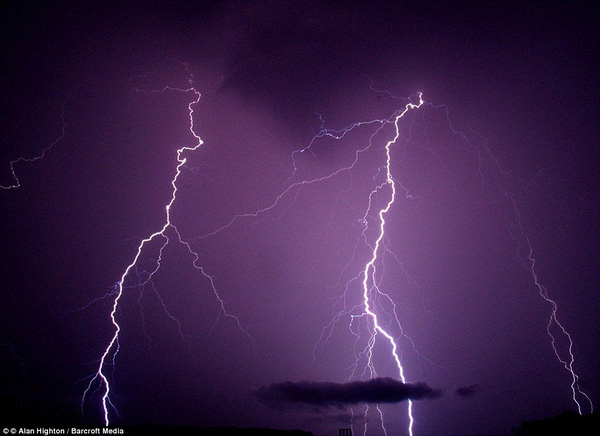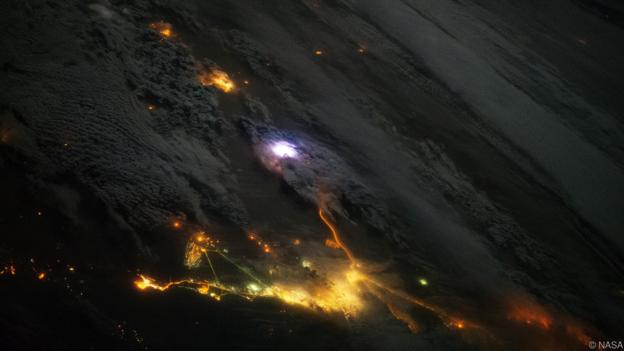Explore the most heavily hit places in the world, 28 lightning bolts every minute, 10 hours a night
Venezuela's Maracaibo Lake, dubbed the earthly hell hell by this land, suffered 1.2 million lightning strikes each year.
- Stunned the impressive moment when lightning struck the crater that was erupting
- We can still survive after being struck by lightning, why?
Maracaibo is the largest saltwater lake in South America, with a length of 99 km, width of 67 km, the most depth up to 60m, an area of 13,210 km2. According to calculations by scientists, every km2 of Lake Maracaibo has to suffer 603 times of lightning strikes every year.

Why is this place so struck by lightning?
According to meteorologists, there are many such storms coming from the terrain. Lake Maracaibo is entirely in a branch of the Andes, encompassing 3 surrounding mountains, the other is the Caribbean Sea. During the day, the steam rises from the lake surface, the night wind from the sea pushes moist air up high to meet cold air masses on the mountain forming clusters of thunderstorms. Inside the clouds, the moisture of moist air collides with the ice crystals of cold air to produce electrical charge and form continuous lightning storms.

In the first 2 months of the year, storms appear sparsely and gradually increase in density afterwards. Clay here reaches the highest density 28 times / minute when in the October rainy season.
According to researchers' calculations, the amount of lightning here produces a source of energy that can light all bulbs in Latin America in a year.

The color of lightning at Lake Maracaibo will change with the molecules in the air. The clay will be white when the air is dry and will gradually turn to red or purple if there is a lot of moisture in the air.
In 2015, Guinness Book of Records officially recognized Maracaibo Lake as the region with the highest density of lightning in the world with a density of 250 rays / km2. Much higher than the old record of the Brahmaputra valley in eastern India, with a density of up to 158 rays / km2 / year.

How does science measure indicators of lightning?
The Tropical Rainfall Measuring Mission (TRMM), a cooperative agency between NASA and the Japanese Space Exploration Agency, will collect data from Maracaibo.
For the past 17 years, they used light-sensitive sensors on satellites, exactly on the ISS space station to record all the lightning in the sky. Since then, the TRMM family has created a map of hot spots with a large density of lightning around the world.
 Thunder observation from ISS.
Thunder observation from ISS.
You should read it
- We can still survive after being struck by lightning, why?
- How hot is hell?
- What is lightning? Why is there lightning?
- Sitting and playing games under a tree in stormy weather, 2 Filipino youths were struck by lightning
- If struck by lightning when flying, is the bullet affected?
- Is the girl hit by lightning when she is on the phone, is it safe to use the phone when there is thunder?
- Please download more than 50 lightning wallpapers, lightning wallpaper for computers
- How to use Photoshop CS5 - Part 26: Create a lightning effect
May be interested
- Fun places not to be missed during the 2017 Halloween festival
 here are the places to celebrate the festival, attractive entertainment program is decorated with bold and horror rooms for this halloween night for your reference.
here are the places to celebrate the festival, attractive entertainment program is decorated with bold and horror rooms for this halloween night for your reference. - Please download more than 50 lightning wallpapers, lightning wallpaper for computers
 lightning wallpaper set, lightning background image in this article includes many colors and will suit the choice of many people.
lightning wallpaper set, lightning background image in this article includes many colors and will suit the choice of many people. - 8 world famous abandoned places make you shiver
 there are many abandoned places in the world and each place carries a special history or contains stories that frighten visitors. here are 8 world-famous abandoned places that make you shudder!
there are many abandoned places in the world and each place carries a special history or contains stories that frighten visitors. here are 8 world-famous abandoned places that make you shudder! - How to use Photoshop CS5 - Part 26: Create a lightning effect
 in the next article of the photoshop tutorial series, we will show you the basic steps to create lightning or lightning effects.
in the next article of the photoshop tutorial series, we will show you the basic steps to create lightning or lightning effects. - Despite the usual laws of physics, these 10 surreal locations are causing headaches for scientists
 in the world there are different and strange places that exist but go against the laws of normal physics, as if they originated from a different planet such as a hundred-degree river, wells of petrifying water. body, radioactive lake, green lava volcano, ...
in the world there are different and strange places that exist but go against the laws of normal physics, as if they originated from a different planet such as a hundred-degree river, wells of petrifying water. body, radioactive lake, green lava volcano, ... - What is USB Type-C, Lightning, which has a superior advantage?
 you've probably heard of usb type-c and lightning, so you understand what these connection standards are and how they have outstanding advantages? if not, read this article right away.
you've probably heard of usb type-c and lightning, so you understand what these connection standards are and how they have outstanding advantages? if not, read this article right away. - Three fireballs spotted burning up over just three hours on the same night
 a trio of space rocks flamed out over the same part of the globe on the same night.
a trio of space rocks flamed out over the same part of the globe on the same night. - 5 reasons why Apple should ditch the Lightning cable
 despite being a recognized apple flagship product, it may be time for the company to retire the lightning cable.
despite being a recognized apple flagship product, it may be time for the company to retire the lightning cable. - Simple method of calculating the safe distance between lightning and people
 if it is lightning, try the simple method based on the technique called 'light-to-blast' below to calculate whether the distance from where you are standing to where the lightning is safe .
if it is lightning, try the simple method based on the technique called 'light-to-blast' below to calculate whether the distance from where you are standing to where the lightning is safe . - Stt for the night the mood couldn't sleep
 the night always reminds us of the romantic memories of someone, at some time, not knowing whether the memories of that night are beautiful or not, only knowing that it never ceases to be sad. ... what do we do between the lonely night and the smoke, the spicy yeast and the shadow of the other person still hiding? well, read some lonely status at night?
the night always reminds us of the romantic memories of someone, at some time, not knowing whether the memories of that night are beautiful or not, only knowing that it never ceases to be sad. ... what do we do between the lonely night and the smoke, the spicy yeast and the shadow of the other person still hiding? well, read some lonely status at night?










 Marvel at the strange surviving animals after the 'head left the neck'
Marvel at the strange surviving animals after the 'head left the neck' Going on the wrong road, the rat snake is re-eaten by the tiger with the lord
Going on the wrong road, the rat snake is re-eaten by the tiger with the lord The most unique dance of love in the natural world of extinct birds
The most unique dance of love in the natural world of extinct birds Looking for 'super athletes' in the animal world?
Looking for 'super athletes' in the animal world? Birds flying in the sky did not escape the claws of this ground hunter
Birds flying in the sky did not escape the claws of this ground hunter Despite the poisons that cause pain, Pallid bats still 'eat' the most unique scorpions in America
Despite the poisons that cause pain, Pallid bats still 'eat' the most unique scorpions in America